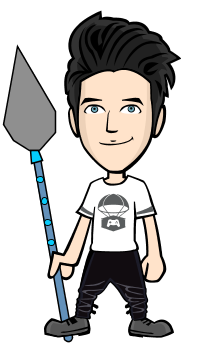"Have you been waiting for this?"
"Worry no more..."
"Because....
"It's..... CST time!"
COGNITIVE STIMULATION THERAPY
Cognitive Stimulation Therapy a.k.a. CST is an alternative psychological intervention to treating mild to moderate dementia. It was pioneered by Dr Aimee Spector and colleagues in 2003. Unlike the traditional method of treating the disease, it is non-pharmaceutical and is more cost-effective! It is composed of 14 sessions with two sessions to be held each week for a total of seven weeks. the number of participants may range from six to ten people.
Video source: Gateway Geriatric Education Center (youtube.com)
Previously on CST, I mentioned its comprehensive meaning (down right here):
"COGNITIVE STIMULATION THERAPY (CST) RESEARCH!!!"
.....and dementia as well!:
"DEMENTIA ( AN INTRODUCTION TO COGNITIVE STIMULATION THERAPY [ CST ] )"
At this juncture, I will be presenting to you the fourteen sessions of the therapy and show you what kind of materials and activities you can do for each session! These are based on our experience in giving the therapy to our selected subjects:
TAKE NOTE: Only the subjects must actively participate. The facilitators are mainly there to facilitate the therapy.
Here they are with their corresponding themes:
Session 1: "Mental Games"
Jigsaw puzzles and BINGO are common games that may stimulate the minds of people who have dementia. Jigsaw puzzles engage the brain to retain information on shapes and colors which hunt the brain to memorize how each piece looks like and the search for what pieces are needed to complete the picture. With continuous exposure to such activity, short-term memory may be augmented (Dennis, 2010).
*Way to go Grandma!
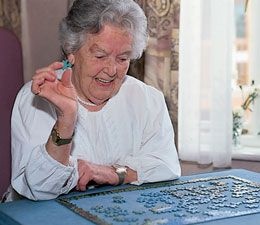
Photo source: yourcarehome.co.uk
ACTIVITIES INCLUDE:
Orienting to the current date, the day of the week, and venue of the therapy
Establishment of a group name
Establishment of a group theme song
Solving of jig-saw puzzle
Playing of BINGO cards
Session 2: "Sounds"
The second session involves the introduction of different animal sounds and the identification of which animal produce such. It consists of activities that may stimulate the participants' visual and hearing senses, and communication.
*Listening to the sound can make them happy!
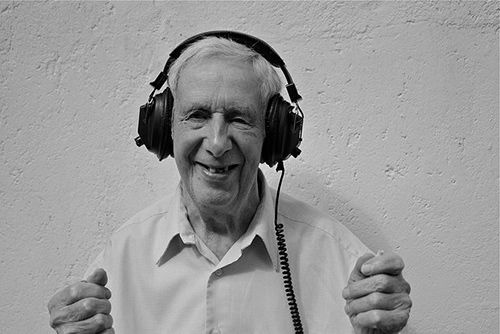
Photo source: rachellaycock.com
ACTIVITIES INCLUDE:
Singing of the group theme song
Matching an animal sound to its correct animal picture and vice versa
Exploration of animal sounds
Session 3: "Childhood"
It is inevitable for someone to have forgotten one of their most remarkable memories, their childhood. Reminiscing their childhood days doesn't only bring back their long gone memories but it also brings so much joy for them.

Photo source: illkeepyouposted.typepad.com
ACTIVITIES INCLUDE:
Asking of "Wh-" questions (e.g. When is your birthday? Where were you born? Etc.)
Drawing of unforgettable childhood memories and sharing it after
Session 4: "Food"
'Taste is a matter of survival, not just a mere pleasure', a line that implies how people tend to disregard one of the senses in the body, the sense of taste. The fourth session in the therapy entails orientation of food, especially to taste sensations.
*Ask them to guess what the taste is!

Photo source: news.agedcareguide.com.au
ACTIVITIES INCLUDE:
Exploration of food using food chart and colored pictures
Orientation to the different taste buds and identification of the four tastes (sweet, sour, salty, and bitter)
Determining the taste for each food to be shown in a picture
Discussion of Go, Grow. and Glow food and classification of various food according to food group.
Session 5: "Current Affairs"
Knowing the happenings of your surrounding is an optimal key to being oriented to the present. A person who is not aware of what is going on around is like a fish with no direction. The fifth session pertains to the discussion of current affairs where news relating to the present is asked or discussed.
*Using the internet is a good way to give them updates. Just don't forget to facilitate them!

Photo source: healingwaysfoundation.org
ACTIVITIES INCLUDE:
Orientation to the current president of the country
Bringing up the current issues of the country
Session 6: "Face/Scenes"
The sixth session tackles the different faces/ scenes where colorful pictures of Filipino actors and actresses, including the participants' idols, and the famous places or scenic spots in the Philippines are being presented.
ACTIVITIES INCLUDE:
Introducing familiar faces of celebrities during the participants' time
Comparing two pictures of celebrities
Showing of the scenic spots of the Philippines
Discussing the pictures thereafter
Session 7: "Word Association"
Associating words can be a problem for people with dementia. The elderly tend to forget or get distracted easily in forming new compound words/ completing phrases. The seventh session involves association of two entirely different words forming a new word, completion of a given phrase, and the supplementation of the next line on a given song.
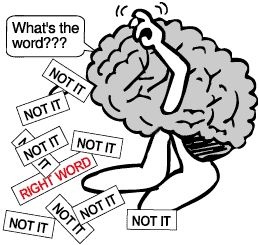
Photo source: ohiovalley.org
ACTIVITIES INCLUDE:
Putting together compound words with illustrations on them (e.g. rain___, tooth____, basket___ )
Filling out the blanks with illustrations on them (e.g. a cup of ___, a table_____ of sugar, a ___ of chocolate )
Providing the next line of a given song
Session 8: "Being Creative"
Creativity fosters independence to an individual. The session entails making artworks. One way of doing this is through coloring a flower and creating a human face by cutting a page of a magazine.
*Or painting (As long as they are capable of it)!
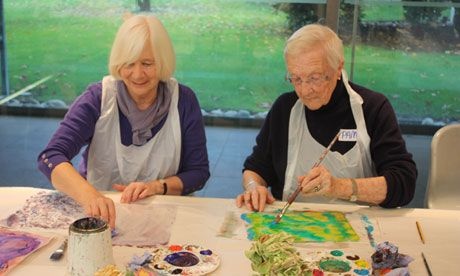
Photo source: the guardian.com
ACTIVITIES INCLUDE:
Drawing of a flower with a leaf, stem, and grass, and birds on top of it
Coloring of the flower
Discussion of the drawing
Creating a face using cut-outs from magazines and presenting the output thereafter
Session 9: "Categorizing Objects"
Categorizing things is not an easy task especially for people with dementia. They get challenged by it since it takes a lot of concentration and use of discretion as to where an object would belong.
ACTIVITIES INCLUDE:
Playing the famous "PANT" game (Places, Animals, Names, and Things)
Classification of the different pictures of animals according to normal habitat (land, water, air, or all)
Identification of the correct action of an animal (crawl, swim, fly, etc)
Session 10: "Orientation"
To be oriented with the environment means to be acquainted with the present. This session deals on orientation, not only to the basic and usual information written on a white paperboard, but also to the places they had visited. The orientation should be something that does not only talk about the present but also to the past that each of the participants had.
ACTIVITIES INCLUDE:
Talking about the places where the participants were born and where they came from
Sharing a piece of their experience in their hometown, their most memorable experience, and the reason that made their place a famous one
Sharing of other childhood experiences, teenage and marriage years, and travelling experiences if there are any.
Session 11: "Using Memory"
Money is such a crucial thing to handle. For demented people, the ability to handle money deteriorates as their ability to count money, do calculations and discern fake bills are impaired.
*Or else, they might lose their entire memory! No way! :(
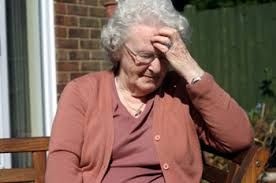
Photo source: neverignore.info
ACTIVITIES INCLUDE:
Orientation to the new face of money
Practicing on how to sell and buy properties using paper money and plastic coins
Adding given amounts of money
Session 12: "Number Games"
Knowing their difficulty in dealing with money, it is important that they get to be oriented with numbers and basic calculations.
*Card games for them too!

Photo source: nextavenue.org
ACTIVITIES INCLUDE:
Counting from numbers one to ten
Pointing at the correct number card per announced number
Guessing of card numbers
Session 13: "Word Games"
There comes a stage of dementia where the affected individual is no longer capable of providing the exact name of an object. He will take time in word-finding thus, resorting himself to just giving substitutes or just describing the word.
*We can facilitate them in playing Scrabble too!

Photo source: senior-brain-health.knoji.com
ACTIVITIES INCLUDE:
Orientation to the English alphabet and singing of the alphabet song
Playing of "Hangman" (To modify the game, general clues may be provided to lessen its difficulty)
Filling out a crossword puzzle
Session 14: "Team Quiz"
To summarize things done would help an individual (not only for demented individuals) to recall on things with ease. It is now the last session of the therapy where excitement and conversation dominates the moment. The participants may share about their feelings now that the therapy is finally concluding.
*This is Savion-Cognitive Stimulation, a computer software program designed for people with mild dementia:
Video source: Melabev (youtube.com)
ACTIVITIES INCLUDE:
Solving of Puzzles (Session 1)
Recognition of the correct animal sound (Session 2)
Classification of food according to taste (Session 4)
Filling out the missing word and identifying the correct answer to a set of questions (Session 7 and 13)
Sorting out of nouns (Session 9)
Summing up a given amount of denomination (Session 12)
*Research conducted by Erika King, Rona Bernardo, Raisa Makasair, and Jan Ortiz (ME)
I guess it'll be until here for now. In my next and final CST blog, I will be posting the results of our research and for that, we can't wait to amaze you! Please anticipate for it. Have a good time on Bitlanders! See you and spread the love! Yours truly, Vanity! :)

